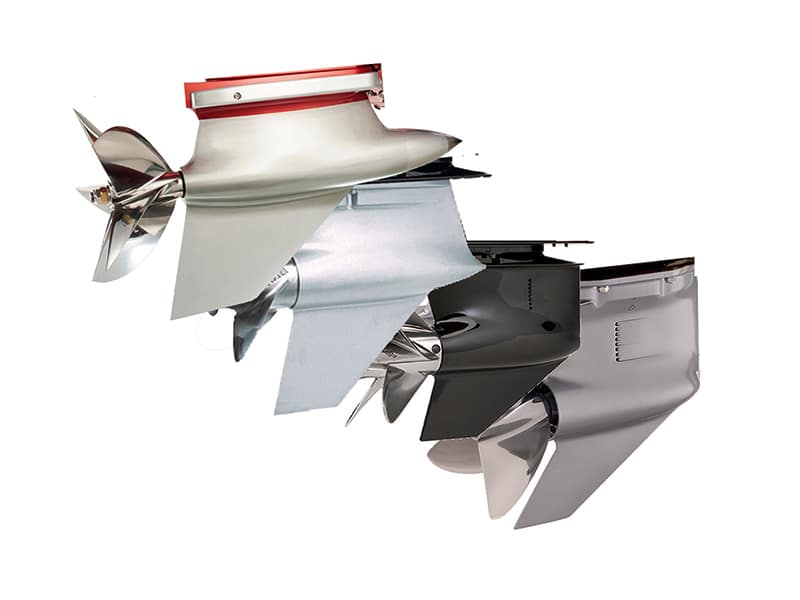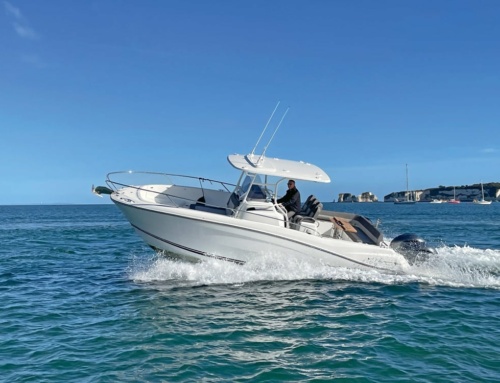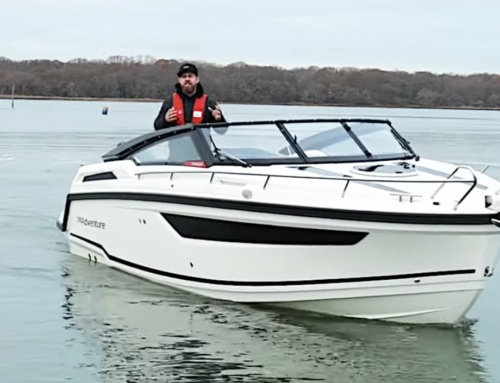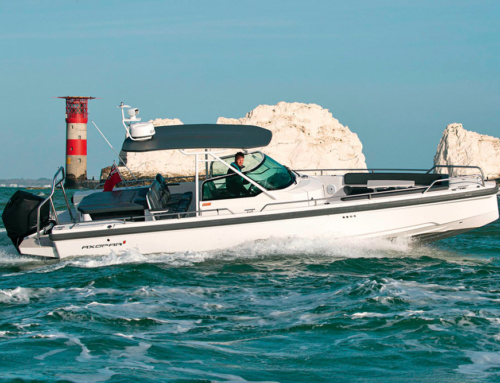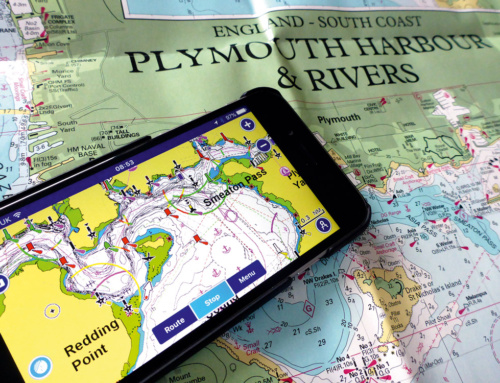- Even though we don’t have a large choice of what gear ratio our lower unit has, knowing how the gear ratio works with propeller sizing to optimise our performance is a benefit.
- Getting the right prop for your boat can be achieved with some disciplined testing of a range of propeller sizes.
Jim Russell, of AeroMarine Research, describes how drive gear ratio works with propeller sizing to optimise performance …
Every engine has a maximum RPM where the engine will achieve its horsepower rating. Manufacturers set the lower-unit (drive) gear ratio and recommended propeller size to allow the engine to reach this maximum RPM and engine HP.
The design, weight and length of the boat, horsepower and torque of the engine, gear ratio of the drive and size of the propeller all work together to affect the boat’s performance. Prop shaft torque and propeller RPM determine which propeller designs will operate best. For example, more torque at the propeller is needed to turn larger-diameter and/or larger-pitch propellers.
That’s a lot of variables, which makes the whole issue of gear ratios and propeller sizing somewhat complex.
There is an optimal propeller pitch and diameter that will do the best job for a boat with an engine of a specific HP at a certain prop shaft RPM. The prop shaft speed is determined, in part, by the gearing between the engine drive shaft and the propeller shaft in the lower unit. Engine manufacturers install lower-unit/drive gear ratios that enable the most efficient combination of propeller diameter and pitch, which can result in the best combination of thrust and speed for particular hulls and varying operating conditions.
For example, larger-diameter propellers can provide better acceleration and less slip, and are more economical on heavily loaded boats, but they generate more drag and require more engine torque at the propeller shaft. Higher-pitch propellers can deliver faster top speed and reduce engine RPM, but have increased slip and poorer hole shot. Propeller performance is very much dependent on the propeller shaft RPM at which it operates. Hopefully there is a range of pitch/diameter propellers that best suit your engine, hull and application.
What do the gears do?
In the simplest of terms, the propeller is driven by the prop shaft, and the propeller shaft is driven by the engine (drive shaft). The gear case (transmission) can change the speed that the propeller shaft rotates at compared to the engine drive shaft.
The propeller rotates at the same speed as the propeller shaft, because it’s fixed to the shaft. The propeller shaft turns slower than the drive shaft due to reduction gears between the drive shaft and propeller shaft. The purpose of the gear ratio is to reduce the speed of the propeller shaft so that an optimum range of propellers (pitch and diameter) can be used efficiently.
The terms ‘gear ratio’ and ‘gear reduction’ can be confusing.
A gear ratio of 2.5:1 means that there is a reduction, so that the prop shaft turns 0.4 times for every revolution of the engine drive shaft.
A higher gear ratio (say, 2.5:1 compared to 1.75:1) has more reduction, and means a comparatively slower prop shaft and more torque at the prop shaft.
A lower gear ratio (say, 1.92:1 compared to 2.08:1) has less reduction, and means a comparatively faster prop shaft speed and less torque at the prop shaft.
Here’s how it works
‘Gear ratio’ refers to the number of drive shaft revolutions for one revolution of the propeller. So if an engine has a 2:1 gear ratio, it means that for one revolution of the propeller the engine drive shaft turns twice.
We can find the propeller shaft RPM by dividing the engine drive shaft RPM by the gear ratio.
For example, if our engine operates at 4000rpm with a 2:1 gear ratio, its prop shaft will turn at 2000rpm.
Prop shaft RPM = 4000rpm / 2.0 = 2000rpm.
If our engine operates at 4000rpm with a 2.50:1 gear ratio, its prop shaft will turn at 1600rpm.
Prop shaft RPM = 4000rpm / 2.50 = 1600rpm.
A higher (numerically) gear ratio means that the speed of the propeller shaft is slower and thus there is a lower number of propeller revolutions than engine drive shaft revolutions.
So why aren’t all gear ratios the same?
Perhaps if all engines used low gear ratios (say, 1:1), the prop shaft would a have higher RPM and our boats would go faster. Well, it’s more complicated than just getting faster prop shaft rotation. Very small gear ratios generate high prop shaft speed, which results in much lower prop shaft torque, and that means we can only use very small-diameter propellers – creating very little thrust. And we need the propeller thrust to push the boat along. So usually, we find that higher-horsepower motors have lower gear ratios than lower-horsepower engines, which typically have higher gear ratios.
The propeller diameter and pitch must be matched to the hull design, weight, engine power, operating conditions and desired speed. There is a huge range of propellers with different diameters and pitches available, but it’s not unlimited.
The purpose of the gear ratio is to reduce the speed of the propeller shaft so that a proper-diameter propeller can be used, which will give the appropriate thrust that our boat needs to move.
Gear ratio availability
It’s much easier to change to a different propeller than it is to change the gear ratio of our lower unit. Outboards sometimes have a choice of gears, but manufacturers generally offer only a single gear ratio that they think will suit most applications. Sterndrives usually have more options for gears. For example, the Mercury Bravo One SM drive comes with gear ratios of 1.35:1 and 1.50:1. Some outboards have choices too – Seven Marine 627 outboards, for example, are offered with a range of gear ratios from 2.33:1 to 1.47:1. Mercury Racing engines offer different lower-unit designs with options for different gear ratios, and Yamaha offer some of their outboards with standard and ‘High Thrust’ gear ratio versions.
What’s the right gear ratio/propeller?
Getting the right prop for your boat can be achieved with some disciplined testing of a range of propeller sizes. Ideally, you’d like to have a gear ratio and propeller sized so that your boat can take the fullest advantage of the engine HP and then torque generated at the propeller. Normally, when your boat is going at full speed (wide open throttle), the engine speed should be at the maximum RPM specified by the manufacturer.
If, at WOT, the engine speed (on the tachometer) is lower than the OEM-specified maximum RPM level, it means that either the gear ratio is too low or the prop is too large (pitch or diameter or both). While the larger prop can improve your hole shot, you’ll suffer at top speed because it has insufficient torque to achieve full engine RPM. This situation will also overload the engine and can eventually cause failure. This is similar to driving your car up a steep hill in fourth gear instead of second.
However, if, at WOT, the engine speed (on the tachometer) is higher than the OEM-specified maximum RPM, this indicates that either the gear ratio is too high or the prop is too small. This is similar to driving your car at 70mph in first gear. This set-up can also make it more difficult to get up onto the plane. It’s possible that a higher top speed might be achieved, but a higher propeller RPM can also cause cavitation (inefficiency) and even blowout, thereby ruining performance.
High-thrust applications
Some applications do really well with higher gear ratios. For example, Yamaha High Thrust 4-stroke outboards are built for jobs that call for more muscle, like pushing a heavy pontoon boat, adding extra kick to a multi-species boat or manoeuvring a sailing boat through a crowded marina.
Their larger lower units and higher gear ratios produce more thrust than conventional outboards of the same horsepower using standard propellers. The 60hp Yamaha conventional 4-stroke engine has a gear ratio of 1.85:1, whereas the High Thrust version comes with a 2.33:1 gear ratio. The higher gear ratio results in lower propeller RPM, which generates more torque, allowing the engine to use higher-diameter, lower-pitch propellers for real ‘grunt work’. In the case of this version of the 60hp engine, the gear case is larger, generating more drag and lower available top speed – so this engine would not be suitable for lightweight boats with a desire to go fast.
Sometimes prop sizing just can’t do it
Sometimes the right prop just doesn’t seem to be available. In these situations, a different lower-unit gear ratio can change the prop shaft RPM and torque, which can open up an opportunity for a different range of pitch/diameter propellers.
There are some cases where optimising propeller diameter/pitch can only partially improve an incorrect gear ratio. If a set-up has a drive with too high a gear ratio (2.14:1 vs 1.61:1) and is compensated by using a more aggressive propeller, the desired performance may be achieved but excessively high torque on the drives can cause premature failure. Similarly, if a boat set-up has an engine lower unit with too low a gear ratio (1.68:1 vs 2.08:1), it could be difficult to find a propeller that is large enough to optimise performance, even though the engine has HP to give.
In any of these cases, a different gear ratio selection would improve the propeller selection range available, and optimising prop sizing and engine power/RPM is achievable for better performance.
How to find your gear ratio
If you don’t know what gear ratio your engine has, and can’t find the specification with the manufacturer, here’s how you can check the gear ratio yourself:
To be safe, remove the ignition key to avoid accidental starting. Remove the spark plugs and shift the motor into forward gear. Place a piece of masking tape on one of the blades and draw a line on it with a black marker. Slowly rotate the flywheel clockwise (while looking down at it) until the mark on the blade reaches the 12:00 o’clock position (centred underneath the motor’s trim tab). Now mark the flywheel for reference and rotate it exactly three turns clockwise. The propeller will turn at the same time, so now observe the new propeller blade mark position.
Compare the location of the propeller blade with the starting position to determine the lower unit’s gear ratio. For example, if the propeller shaft has turned one full revolution and then stops at about the 4:00 o’clock position, then the shaft has turned 1.33 times compared to the engine’s three revolutions, so the gear ratio is 2.25:1 (or a .44 reduction at the propeller).
The speed prediction formula
There is one last piece of information that can be very valuable when estimating the potential speed that a particular gear ratio and propeller size can deliver.
The speed of your hull can always be calculated using an engineering formula. While some of the variables for the formula may require some experience to apply, the formula works for all hulls, all designs of boats, all power and drive packages, and all speeds.
Example:
V = [RPM x PP x (1-S) x GR] / [1056]
Here’s an example….
RPM = 6000rpm (rev/minute)
PP = 24 (inches)
S = 0.12 (12% slip)
GR = 1.87:1 gear ratio (0.535 reduction at prop)
Then …
Vactual = [6000 x 24 x (1-0.12) x .535] / 1056 = 64.2mph
The bottom line
The performance effect of lower-unit gear ratios is often a confusing subject. Even the terminology used is sometimes baffling.
The purpose of the gear ratio is to reduce the speed of the propeller shaft so that an optimum range of propeller sizes can be used efficiently. Higher gear ratio drives have more ‘reduction’ and cause the propeller shaft to turn slower. Sometimes this higher ratio allows the use of a range of bigger propellers that are more suitable for a boat’s set-up.
Even though we don’t have a large choice of what gear ratio our lower unit has, knowing how the gear ratio works with propeller sizing to optimise our performance is a benefit.
Safe powerboating! Wear your kill cord!
- Read more about performance vee hull and tunnel boat design and set-up in Secrets of Tunnel Boat Design (ISBN# 1-894933-30-3).
- See more about the ‘Tunnel Boat/Vee Boat Design Program’ software at www.aeromarineresearch.com/tbdp6.html
Linksfor reference:
- ‘Vee Boat Design Program’ software – www.aeromarineresearch.com/vbdp.html
- ‘Tunnel Boat Design Program’ software – www.aeromarineresearch.com/tbdp6.html
- Secrets of Tunnel Boat Design book – www.aeromarineresearch.com/stbd2.html
- Secrets of Propeller Design book – www.aeromarineresearch.com/secretsofpropellerdesign.html
- ‘PropWorks2’ software for speed prediction and propeller selection – www.aeromarineresearch.com/prop2.html
- All the above are available on the AeroMarine Research website at www.aeromarineresearch.com.
About AeroMarine Research
Jim Russell is a professional engineer with a mechanical and aeronautics background. Currently living in Canada, he has done extensive aerodynamic research at the University of Michigan, OH, and the University of Toronto, Canada, and marine research at the NRC water channel laboratory in Ottawa, Canada. His published works and papers are highly acclaimed, and are specifically related to the aerodynamics and hydrodynamics of high-performance catamarans and tunnel boats, as well as vee and vee-pad hulls.
Russell has designed and built many tunnel and performance boats. As a professional race driver, he piloted tunnel boats to Canadian and North American championships. He has written powerboating articles for many worldwide performance magazines and has covered UIM and APBA powerboat races. He has appeared on SpeedVision’s Powerboat Television as a guest expert on ‘tunnel hulls’, and was performance/design technical consultant on National Geographic’s Thrill Zone TV show and editorial consultant on the Discovery Channel’s What Happened Next?
Russell is the author of the books Secrets of Tunnel Boat Design and Secrets of Propeller Design. His company designed and published the well-known powerboat design software ‘Tunnel Boat Design Program’ and ‘Vee Boat Design Program’ specifically for the design and performance analysis of tunnel boats, powered catamarans, and performance vee and vee-pad hulls. ‘Jimboat’ is recognised for his advanced aerodynamic and hydrodynamic research and consulting on powerboat design, performance analysis, safety analysis, accident investigation, expert witness and education/training.

